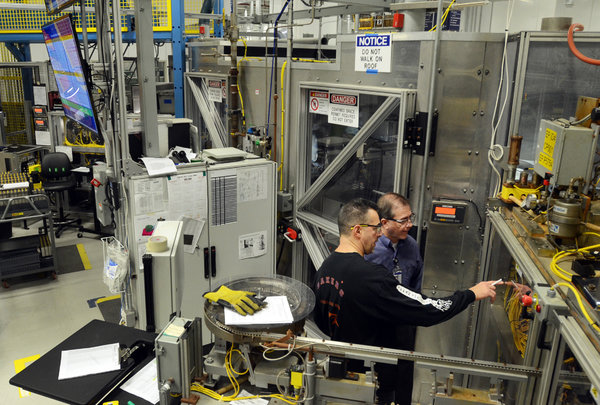High-Tech Factories Built to Be Engines of Innovation
December 13, 2012
“In sector after sector, we’ve lost our innovation edge because we don’t produce goods here anymore,” said Mitzi Montoya, dean of the college of technology and innovation at Arizona State University.
These experts say that in industries that produce complex, high-technology products — things like bioengineered tissues, not light bulbs — companies that keep their research and manufacturing employees close together might be more innovative than businesses that develop a schematic and send it overseas for low-wage workers to make. Moreover, clusters of manufacturers, where workers and ideas can naturally flow between companies, might prove more productive and innovative than the same businesses if they were spread across the country.
A General Electric facility in upstate New York provides a test case. In a custom-built facility the size of four football fields, workers are casting into thin tubes a kind of ceramic that G.E. invented. Those tubes get filled with a secret chemical “brownie mix,” packaged into batteries and shipped across the world.
The plant sits just a few miles down the road from the research campus where G.E. scientists developed the technology. That allows them to work out kinks on the assembly line, and test prototypes of and uses for the battery, the company’s scientists said.
“We’re not thinking about just one generation,” said Glen Merfeld of G.E.’s chemical energy systems laboratory, showing off a test battery his employees had run into exhaustion. “We’re working on the second, the third, the fourth, the fifth.”
The idea is to knit together manufacturing, design, prototyping and production, said Michael Idelchik, vice president for advanced technologies, who holds a dozen patents himself. “We believe that rather than a sequential process where you look at product design and then how to manufacture it, there is a simultaneous process,” Mr. Idelchik said. “We think it is key for sustaining our long-term competitive advantage.”
Economists and policy experts are now researching whether such strategies offer the same benefits for other businesses — and examining how those benefits might show up in national data on innovation, productivity and growth.
At the Massachusetts Institute of Technology, Suzanne Berger has helped to start the Production in the Innovation Economy project to study the subject. “It is something that’s very difficult to establish systematically,” said Professor Berger. “You really have to be willing to look at case-by-case evidence, qualitative evidence. That’s what we’re trying to do.”
Thus far, she said, the anecdotal evidence from about 200 companies has proved striking, with company after company detailing the advantages of keeping makers and thinkers together. That does not mean every business, she stressed. Companies with products early in their life cycle seemed to benefit more than ones with products on the market for years. So did companies making especially complicated or advanced goods, from new medicines to new machines.
“It’s the companies where the challenge of producing on a commercial scale requires levels of scientific activity that are just as complex as the original challenge of developing the technology,” Professor Berger said.
Economists said that while the link between making and innovating within individual businesses was not yet well established, the link between making and innovating between different companies was.
It is what they call a “spillover” effect: manufacturing companies near one another create a kind of commons. Workers exchange ideas over drinks and at baseball games. They switch jobs, taking their knowledge with them. They draw other companies, who compete to offer them goods and services. It all adds up to a more productive, more innovative economy.
For instance, the economist Michael Greenstone of M.I.T.analyzed what happened to towns after marquee manufacturing plants, like a BMW factory, moved in. Other factories in the town became more productive, he and his co-authors found. Wages rose, too. Such evidence has left many economists and other experts concerned about the overseas movement of manufacturing jobs and facilities over the past 30 years.
The bulk of those jobs, experts were keen to note, were jobs that the United States probably would not want back — like repetitive assembly positions. But many were more cerebral positions, where manufacturing workers were not simply following a schematic, but solving problems.
“Outsourcing has not stopped with low-value tasks like simple assembly or circuit-board stuffing,” wrote Willy C. Shih and Gary P. Pisano of Harvard Business School. “Sophisticated engineering and manufacturing capabilities that underpin innovation in a wide range of products have been rapidly leaving, too.”
That might have left the United States falling behind in some fast-growing areas of cutting-edge technology, like bioscience and nanotechnology.
“The manufacturing process itself is going through an innovation revolution,” said Stephen Hoover, chief executive of Xerox PARC. “It’s not four million people on an assembly line. It’s a small number of really highly skilled people.”
The White House has studied these arguments and evidence, and found itself convinced.
“A vibrant manufacturing sector is inextricably linked to our capacity as a nation to innovate,” concludes a White House report published this year. It has pushed for allocating billions of dollars to an array of policies to bring back manufacturing and keep it in the United States.
Experts and executives for manufacturing companies described the proposals as helpful, but too small to make a significant difference. When asked what might help rebuild the country’s manufacturing commons faster, they mentioned things like a larger immigration program for science, engineering and technology graduates; tripling government investment in basic research and development; hugely increasing export financing; and changing the country’s regulatory scheme.
“Other nations are competing intensely to create an attractive business and regulatory environment for manufacturing firms” said James Manyika
, dire
ctor of the McKinsey Global Institute, which recently published a report on manufacturing’s link with innovation. “The United States just hasn’t done this as aggressively as other countries have.”




Leave a Reply
Want to join the discussion?Feel free to contribute!